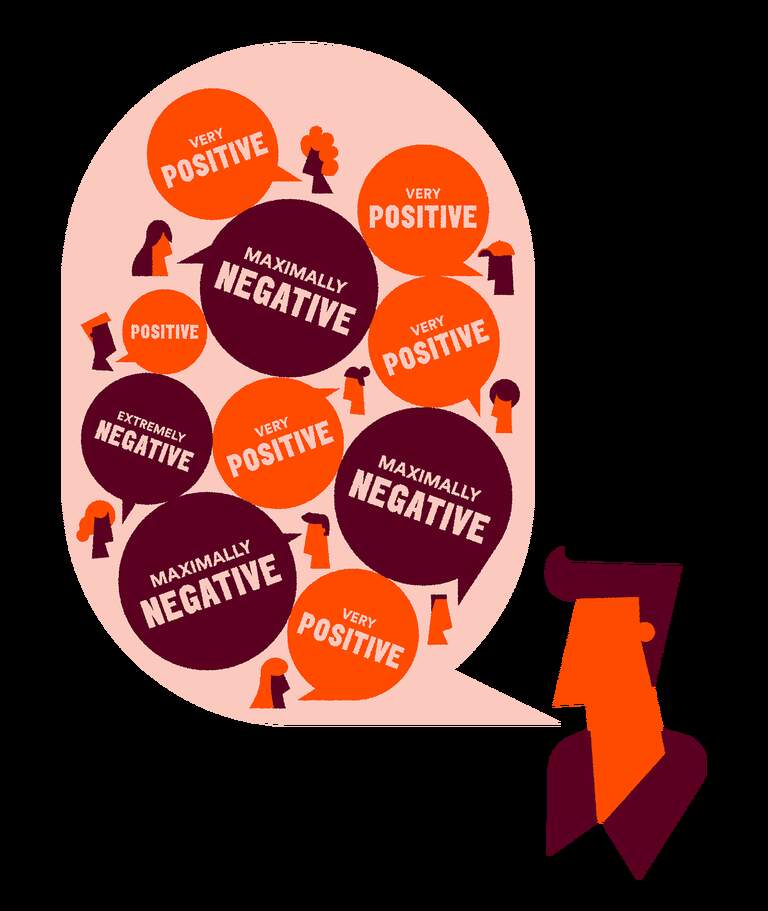Featured Faculty
Sandy & Morton Goldman Professor of Entrepreneurial Studies in Marketing; Professor of Marketing

Riley Mann
Imagine you’re out with a group of friends and trying to decide where to eat dinner. If you’re craving pasta, you can take one of two general approaches to getting your way: you can try to build low-level support among a larger number of people (“Spaghetti could be nice, right?”) or you can work to get a smaller number of die-hards on Team “Italian Food or Bust.” Which tack would you take to convince the group?
If you’re like most people, you probably instinctively favor the first strategy, which emphasizes consensus, over the second, which relies on extremity. In fact, new research led by Derek Rucker, a professor of marketing at the Kellogg School, finds that people have a remarkably strong preference for consensus-based persuasion strategies.
“Time and time again, people tend to gravitate toward getting more people on their side at the cost of having people who are true advocates,” Rucker says. In fact, the research found, people will choose consensus-based strategies even in situations when they are objectively inferior to extremity-based strategies.
Seeking consensus, Rucker adds, can be an “effective strategy and even an objectively correct strategy in some cases, but the issue is we can become so attached to it that we misapply it.”
While much psychological research has examined how people approach the task of persuading individuals—so much so that Rucker calls it a “staple of persuasion research”—scant research has focused on efforts to sway multiple people at the same time. That’s a surprising oversight, given how many important decisions are made in group contexts. “It’s a situation we actually find ourselves in a lot, where you are surrounded by six people at the table who may or may not agree with you,” Rucker says.
When the research team—made up of Rucker, Kellogg PhD students Jesse D’Agostino and Mark Dyer, and Zakary L. Tormala of Stanford University—began thinking through the different approaches people might take, consensus and extremity seemed like two equally appealing paths. Still, even amongst themselves, the researchers were unsure which would have more appeal. After all, both are reasonable approaches. With an extremity strategy, you have the benefit of staunch advocates; with a consensus strategy, you have the comfort of numbers.


Uncertain about what would happen, the research team began with a simple experiment or “persuasion game” that allowed them to put these two tactics head-to-head.
Study participants were told they were giving a speech in hopes of persuading a group of ten people to support an idea. Their goal, the researchers explained, was to convince a simple majority of the group. Support could range from maximally positive to somewhat positive; similarly, dissent could range from maximally negative to somewhat negative.
Next, participants were shown diagrams depicting two different approaches to winning the group’s support and asked to pick between them. Under Strategy A—a consensus strategy—everyone in the group would support the idea, with eight people feeling somewhat positive and two feeling very positive. With Strategy B—an extremity strategy—only six of ten group members would support the idea, but five of them would feel very positive.


Importantly, both strategies accomplished the stated goal of convincing a majority, just in different ways. As such, participants could not make a wrong choice when it came to winning this game. Despite the choice being seemingly irrelevant, the consensus strategy was the most popular by a landslide—of the 102 participants in the experiment, 88 (or 86 percent) chose Strategy A.
“We learned people exhibited an overwhelming preference for consensus,” Rucker says.
But just how far does this preference for consensus extend? Would people still choose a consensus-based strategy—even when it produced an outcome where people could lose in a battle of persuasion?
To find out, the researchers recruited 198 new participants. As in the previous experiment, these participants were told they would be giving a speech aimed at convincing a majority of their ten-person audience to support their idea. This time, however, support was expressed numerically, with +5 indicating the strongest support and -5 indicating the strongest opposition.
Participants were then presented with four strategies from which to choose.
Of note, the researchers designed the paradigm such that all the strategies except Strategy 3 would succeed in achieving the participants’ goal of winning majority support.
“Time and time again, people tend to gravitate toward getting more people on their side at the cost of having people who are true advocates.”
—
Derek Rucker
But the researchers introduced a new wrinkle. Half of the participants were told that a competitor would also give a speech and could, if successful, reduce each audience member’s support by either one or two points. Under this condition, only Strategy 4—which emphasizes extremity more than consensus—would be guaranteed to weather the competitor’s attack and allow participants to guarantee success.
Finally, the researchers instructed both groups of participants—those who had learned about the competitor and those who had not—to choose their preferred strategy.
Consistently with the results of the first experiment, a majority of participants in the no-competition group (57.8 percent) selected Strategy 1 and another 29.4 percent selected Strategy 2. In other words, 87.2 percent of participants opted for a consensus-based strategy—another sign of the overwhelming preference for consensus.
In the competition group, 24.7 percent of participants figured out that Strategy 4 was the only unbeatable option. But 37.6 and 29 percent still selected Strategies 1 and 2, respectively—that is, 66.6 percent chose a consensus-based strategy that put them at risk of losing.
“Some people do figure it out,” D’Agostino explains. Essentially, these participants suss out that a consensus-based strategy will not serve their interests in this scenario. “But the majority still go with consensus even though it will render them more susceptible to losing.”
To Rucker and his colleagues, the second study suggested that the preference for consensus may be a heuristic, a mental shortcut we use to make decisions, rather than a thought-through decision.
If consensus was indeed operating more as a heuristic as opposed to an intentional decision, the researchers reasoned, then it should be possible to undercut the shortcut by forcing participants to think about their decisions more carefully. So, for their final experiment, they put the matter to the test.
The setup was similar to the previous experiment. Participants were divided into three groups—a competition group, a competition group in which participants were encouraged to think about their choice, and a no-competition group—and presented with two strategies. Strategy 1 had 70 percent support and an average extremity of 3.0, while Strategy 2 had 90 percent support but an average extremity of just 1.89. In the face of competition, only Strategy 1 was unbeatable.
Next, participants in the competition group encouraged to think about their choice were prompted to consider how a competitor’s actions might change the outcome in both strategies. The researchers also offered a small bonus for selecting a winning strategy. Together, these two procedural changes were aimed at getting this subgroup of participants to pay closer attention before making their choice.
In the absence of competition, participants once again heavily favored Strategy 2, which emphasized consensus over extremity.
In the competition group, just as in the previous experiment, the preference for consensus diminished somewhat, but a majority of participants (62.6 percent) still chose Strategy 2, even though it risked failure.
However, among competition-group participants who had been prompted to think through their choice more carefully, 73 percent selected the unbeatable extremity strategy.
Forcing people to think “flips the effect,” Dyer explains, because “a majority start to realize that the competitor is going to win if they follow their gut instinct toward consensus.”
Why does this happen? Rucker and the team explored a few ideas. As social creatures, we tend to enjoy group harmony; the appeal of consensus appears to arise, in part, because it feels more comfortable when a group is in general (if tepid) agreement than when there are strong voices on both sides of an issue. In addition, people also seem to think that there is “safety in numbers,” such that they can’t lose when they have more people on their side. Of course, as the experiments show, this is not inherently true.
Still, the research offers a lot more to explore. Rucker and his colleagues want to know if there are any situations that might evoke a strong preference for extremity instead. And they hope to adapt their “persuasion games” to mimic more-complex real-world situations. For example, how might group persuasion tactics play out when two opposing perspectives are presented sequentially, with opportunities for debate and rebuttal?
“Our paper ultimately raises far more questions than it solves, which is what we want to do as academics,” Rucker says. “This is an aspect of research that is both elucidating and exciting.”
Susie Allen is the senior research editor of Kellogg Insight.
Rucker, Derek D., Jesse D'Agostino, Mark Dyer, and Zakary L Tormala. 2024. “The Allure of Consensus: People (Over)seek Consensus in Selecting Group Persuasion Strategies.” Journal of Personality and Social Psychology.